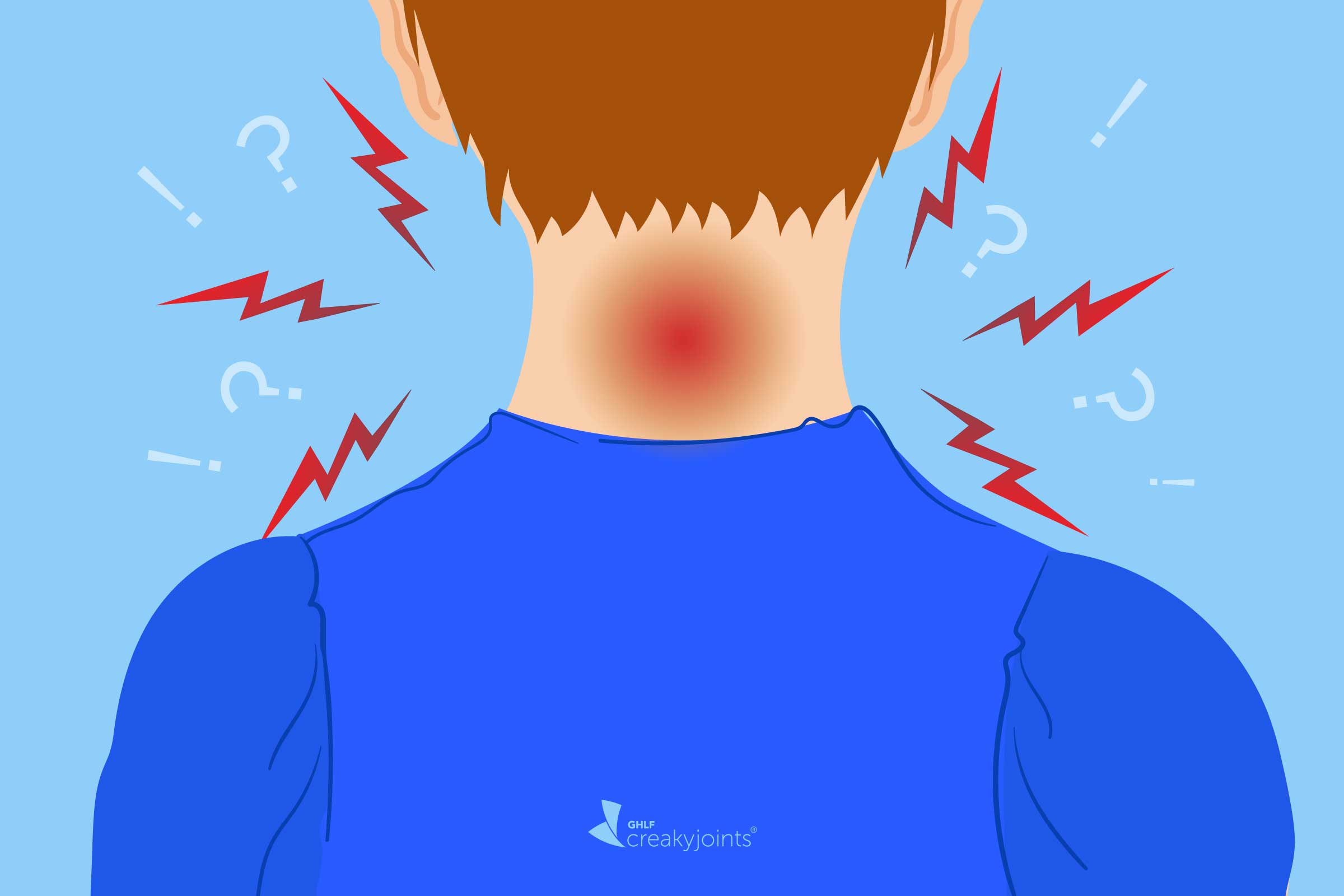When you think of arthritis, you might think of creaky knees or painful, swollen fingers. But if your wrist is feeling swollen and stiff, this wrist pain may be caused by arthritis too.
The wrist is a complex joint that connects the hand to the forearm. It is formed by the two bones of the forearm — the radius and the ulna — and eight small carpal bones that sit between your fingers and your arm. The carpal bones are arranged in two rows at the base of the hand, with four bones in each row. The joint surface of each bone is covered with articular cartilage, which is a slippery substance that protects and cushions the bones as you move your hand and wrist.
Arthritis in the wrist is often the cause of wrist pain. According to one estimate, one in seven people, or 13.6 percent, in the United States has wrist arthritis. But the kind of arthritis that affects your wrist might not be so obvious. Two of the most common forms of arthritis — osteoarthritis (OA, or degenerative arthritis caused by wear and tear on the joints) and rheumatoid arthritis (RA, an inflammatory type of arthritis caused by inflammation in the joint) — share many symptoms in common. Plus, other, less common forms of inflammatory arthritis affect the wrist that your doctor will need to consider as well.
“Besides pain, loss of flexibility in the wrist may affect your ability to use your hands to dress, eat, and do many work tasks,” says Steven Eyanson, MD, a retired rheumatologist who was in private practice at Physicians Clinic of Iowa in Cedar Rapids and a clinical assistant professor at the University of Iowa in Iowa City.
Learn more about what causes arthritis in the wrist and how arthritis in the wrist is treated.
Click Here to Visit the Store and find Much More….
Symptoms of Arthritis in the Wrist
Not everyone with arthritis in the wrist will experience symptoms. When symptoms do occur, the severity can vary greatly from person to person. For some patients, wrist arthritis symptoms aren’t constant, but may come and go depending on their level of activity and other factors. You may have done something to the wrist — such as repeated overuse, lifting, carrying, or bending — that aggravates it and causes a flare. Then it returns to its baseline.
“The number one symptom of wrist arthritis is pain,” says Chadwick Hampton, MD, an orthopedic surgeon at Palm Beach Gardens Medical Center in Palm Beach Gardens, Florida. The pain may be sharp, depending on the motion, says Dr. Eyanson. Or it may be dull and deep if it’s an inflammatory type of arthritis like rheumatoid arthritis.
The other main symptom of wrist arthritis is a change in your grip strength, such as an inability to open jars, use keys, or turn doorknobs.
Click Here to Visit the Store and find Much More….
Common signs and symptoms of arthritis of the wrist include:
- Stiffness
- Swelling
- Redness
- Weakness
- Joint pain and swelling around joints
- Difficulty gripping objects
- Limited or reduced range of motion such as problems washing, combing hair, or brushing teeth
- Grinding, clicking, or grinding sound when you move
Types of Arthritis that Can Cause Arthritis in the Wrist
Many different kinds of arthritis can affect the wrist. Here is more information on four of the most common types.
About 30 million Americans have osteoarthritis, which makes it the most common type of arthritis. It’s more common with older age, but it can occur in younger people too, depending on such factors as injuries and genetic risk. In osteoarthritis of the wrist, the smooth, slippery articular cartilage that covers the ends of the bones gradually wears away over time. Since cartilage has little to no blood supply, it has little ability to heal or regenerate when it gets injured or worn down.
Osteoarthritis in the wrist can also develop from a condition called Kienböck’s disease. Here, the blood supply to one of the carpal bones — the lunate — is disrupted. That causes the bone to deteriorate. Over time, this can lead to structural changes and arthritis in the joints around the lunate.
Post-traumatic arthritis is a common form of osteoarthritis that happens as a result of physical injury to a joint such as from sports, a car accident, a fall, or other trauma. Injuries can damage the bone and/or cartilage, which changes the joint mechanics and makes it wear out more quickly. Post-traumatic arthritis symptoms in the wrist may appear within a few years, or it can take decades for joint damage from an injury to cause pain.
About 1.5 million people in the U.S. have rheumatoid arthritis (RA). RA is a chronic inflammatory disease that causes pain, stiffness, swelling, and loss of function in joints throughout the body.
Rheumatoid arthritis is caused by autoimmunity, which is a malfunction in your immune system. Normally, your immune system reacts to any external threats (such as viruses, bacteria, or parasites that could cause disease) by releasing antibodies, white blood cells of various types, and other defense systems. But in autoimmune diseases like RA, your body’s immune system is confused for some reason. It attacks your own healthy tissue when there’s no reason to.
RA often starts in smaller joints, such as those found in the fingers and wrist. RA is often symmetrical, which means it affects the same joint on both sides of the body. OA, for example, might affect only your right wrist, but RA is more likely to affect both your wrists.
As RA progresses, it can affect the range of motion and flexibility of the wrist joints. Because RA causes widespread inflammation in your body, it’s not common that wrist pain would be your only symptom. You’re also likely to experience pain in other joints, especially your fingers or toes, as well as fatigue, low-grade fever, and these other rheumatoid arthritis symptoms.
Psoriatic arthritis (PsA) is another kind of inflammatory arthritis linked to psoriasis (a disease that causes red, scaly rashes on the skin). Psoriatic arthritis in the wrist might cause similar symptoms to those of RA — pain, stiffness, swelling, and loss of function — but there may be additional PsA symptoms that occur that are more unique to PsA. People with PsA are likely to have problems with their nails, such as pitting and crumbling, as well as swollen fingers and toes, a condition called dactylitis that makes them appear sausage-like. PsA joint pain is also less likely to be symmetrical than that of RA.
Click Here to Visit the Store and find Much More….
Other Possible Causes of Wrist Pain
Wrist pain is also the main symptom of two other common problems: carpal tunnel syndrome and tendinitis.
Carpal tunnel occurs when a major nerve in the hand — the median nerve — becomes compressed in the carpal tunnel, a narrow passageway on the palm side of your wrist that also houses the tendons that bend the fingers. Interestingly, having arthritis raises your risk of developing carpal tunnel, so you could have both conditions at the same time. The nature of the pain in carpal tunnel usually sets it apart from arthritis, though: It often causes numbness and tingling in the first three fingers (thumb, index, and middle finger), as well as these other carpal tunnel symptoms.
Tendons are thick cords that join your muscles to your bones. When tendons become irritated or inflamed, that’s called tendinitis. Tendinitis causes acute pain and tenderness that makes it difficult to move the affected joint. Any tendon can develop tendonitis, but you’re more likely to develop it in your shoulder, knee, elbow, heel, or wrist. The most common cause of tendonitis is a repetitive action. You may develop tendinitis if you make the same motion frequently while playing sports, for example.
How Arthritis in the Wrist Is Diagnosed
First, your doctor will ask about your symptoms and medical history and perform a physical exam. During your physical exam, your doctor will examine your wrist for swelling and pain.
Next, your doctor will examine the range of motion of the wrist itself. Your doctor may have you twist and flex both wrists in every direction to assess your range of motion. They will manipulate your wrist and thumb joints and ask if you feel pain in your wrists and thumbs. This exam can show how mild or severe the arthritis is, or if another condition is causing symptoms, such as carpal tunnel syndrome or tendinitis.
If your doctor suspects inflammatory arthritis, they will order blood tests to detect the presence of certain antibodies, such as rheumatoid factor or anti-CCP, which help identify RA and other types of inflammatory arthritis. They may also order blood tests that look for levels of inflammation, such as C-reactive protein (CRP) and erythrocyte sedimentation rate (ESR).
Your doctor may order imaging tests, such as X-rays or MRIs, to assess whether you have joint damage in the wrist.
Treatment for Arthritis in the Wrist
Various medications can help relieve inflammation and offer pain relief.
Nonsteroidal anti-inflammatory medications (NSAIDs) like aspirin, naproxen, and ibuprofen (all available over the counter) can help relieve pain and inflammation. They’re commonly used to treat pain and stiffness in OA and inflammatory arthritis. NSAIDS don’t slow the progression of arthritis. But they do help treat acute symptoms like pain and inflammation. NSAIDs are also available by prescription at stronger doses for shorter-term use. All NSAIDs, both OTC and prescription, can have significant side effects, including gastrointestinal complications and an increased risk of heart disease, so talk to your doctor about the right dosage and duration for you. Your doctor might also prescribe a topical gel NSAID, which can be helpful if oral medications aren’t helping with the pain. A common one is diclofenac (Voltaren), says Dr. Hampton.
If you have an inflammatory arthritis like rheumatoid arthritis, disease-modifying anti-rheumatic drugs (DMARDs) such as methotrexate are used as a first-line therapy to help reduce the immune system activity that triggers inflammation and pain. DMARDs are not used for osteoarthritis.
Corticosteroids like prednisone are powerful anti-inflammatory agents that can quickly relieve pain and swelling. “This type of therapy is often employed as a temporary or ‘bridge’ therapy [for inflammatory arthritis] while patients wait for DMARDs to take effect,” says Brian Golden, MD, a rheumatologist and clinical associate professor in the department of medicine at NYU Langone Health in New York City. It’s best to use corticosteroids in the lowest possible does for short periods of time, as they can cause a range of serious side effects, including bone thinning and high blood sugar.
Click Here to Visit the Store and find Much More….
An occasional steroid shot in the wrist can offer temporary pain relief and reduce inflammation. Shots shouldn’t be done repeatedly, as frequent injections can damage cartilage. Many doctors limit cortisone injections in a joint to no more than three or four times a year.
Biologics are a newer class of DMARD that targets specific immune system pathways to reduce immune system activity that is causing inflammation and pain. They’re used to treat inflammatory types of arthritis, such as rheumatoid arthritis and psoriatic arthritis, and are typically offered after patients haven’t responded to “conventional” DMARDs like methotrexate.
Exercise for Arthritis in the Wrist
It’s important to exercise your wrist joints to promote range of motion, improve flexibility, and prevent additional damage. Your doctor will likely send you for physical therapy so you can do these exercises under supervision and then repeat them at home. Your physical therapist can develop a program that’s right for you. “The stronger the muscles are around the joint, the better you’ll feel,” says Dr. Hampton. Here are some range-of-motion exercises, including some for your wrist, which you can try at home.
In addition to physical therapy, it’s a good idea to do regular cardiovascular and strength training exercises that don’t put too much pressure on your wrist joints. Swimming and water exercises, for example, places less pressure on the joints since water helps supports the body. Tai chi and yoga involve gentle, flowing movements. (Be sure to ask your yoga teacher for modifications that don’t stress your wrist.) Walking is low-impact exercise that’s well-suited to people with arthritis. Avoid any exercises with a pushing movement or that put weight on the wrist (such as a handstand or a bench press) as that could exacerbate your wrist pain, says Dr. Hampton. “You want to stay active,” he says. “Keep the muscles and tendons around the joint strong. That will help with pain.”
Home Remedies for Arthritis in the Wrist
You can take some measures at home to ease your wrist pain.
Support braces can help support wrist movements and ease physical stress. They can’t prevent severe injuries, but they can help you do daily activities with less discomfort. You can get a custom-made or over-the-counter splint to cover your wrist or forearm. Dr. Hampton suggests to his patients that they wear the splint at night while they sleep. He says its compression offers pain relief.
Some people have found that their symptoms improve when wearing special arthritis gloves. They’re tight, often fingerless, gloves that may improve symptoms.
Cold therapy can provide relief for inflamed joints in the wrist. Cold constricts the blood vessels in the muscles, which decreases blood flow to the joint area to help reduce swelling and inflammation. Heat therapy warms the skin and the joints, which causes blood vessels to dilate, and sends more oxygen and nutrients to the joints and muscles. Try both and see which makes you feel best.
Surgery for Arthritis in the Wrist
Surgery isn’t often needed to treat arthritis in the wrist. But surgery is considered when other treatments don’t relieve pain, wrist arthritis symptoms are severe, or when you can’t use your wrist or hand well. Surgical procedures include the following.
This is the least invasive of the three kinds of wrist surgery, says Dr. Hampton. The arthritic bones of the wrist joint are removed, which diminishes pain. Motion is preserved because there is no fusion. Proximal row carpectomy is only an option for some types of wrist arthritis. “Not everybody is a candidate,” says Dr. Hampton. It depends on where the arthritis is located. You have two rows of four bones in the wrist. If your arthritis is in the proximal row (the one closer to your arm), then you’re a candidate. If it’s in your distal row (the one closer to your hand), then you’re not a candidate. If your arthritis is in both the distal and proximal rows, then you’ll need a wrist fusion. This surgery can provide pain relief while preserving motion.
This procedure eliminates all movement at the wrist joint. Wrist fusion secures the bones of the forearm to the bones in the wrist and hand. “You’re trying to fuse all the bones together so they don’t move anymore,” says Dr. Hampton. “Fusions heal, but you lose movement in the wrist. If you’re at the point of getting this surgery, you’re in debilitating pain and you have no other choice. Either you keep living like this or you get rid of the pain and lose your motion.” The surgery provides pain relief, but the loss of motion can prevent you from doing some daily activities like lifting and manual work that involves your hands like carpentry, says David Geier, MD, an orthopedic surgeon, sports medicine specialist, and author of That’s Gotta Hurt: The Injuries That Changed Sports Forever.
This is the most invasive of the three surgeries, says Dr. Hampton. Here, damaged bone is removed and replaced with a metal and plastic implant. Dr. Hampton says this surgery isn’t done often as the implant in the wrist joint hasn’t been perfected like it has been in hip or knee joint replacements. It was done more in the past and not found to always be successful. “The rare circumstances where this procedure is performed involves older, less active patients who are in excruciating pain that’s not relieved by less invasive treatments,” says Dr. Geier.

Click Here to Visit the Store and find Much More….
For More Information Related to Fibromyalgia Visit below sites:
References:
Fibromyalgia Contact Us Directly
Click here to Contact us Directly on Inbox
Official Fibromyalgia Blogs
Click here to Get the latest Chronic illness Updates
Fibromyalgia Stores









